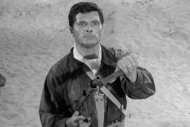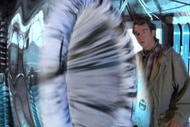Create a free profile to get unlimited access to exclusive videos, sweepstakes, and more!
Dragula pushes boundaries while serving up scary delights

Filth! Horror! Glamour!
These are the principles at the heart of the drag reality competition series Dragula. Conceived by veteran drag queens The Boulet Brothers (aka Dracmorda and Swanthula Boulet), what began as a monthly club night in Los Angeles and San Francisco has since evolved into a TV show with a $25,000 prize for the World’s Next Drag Supermonster. Debuting on the Hey Qween! YouTube channel in 2016, it has since gone on to air on Canadian network OutTV and Amazon Prime. In November of last year, Seasons 2 and 3 landed on Netflix, which means the deliciously gory and filthy reality series should get the coveted binge bump. For fans of drag with a strong amount of horror references, Dragula is the show for you.
Over the last decade, the drag scene has exploded in mainstream entertainment, with shows such as RuPaul’s Drag Race introducing an array of incredible performers as well as educating viewers in LGBTQ+ history and subculture. However, with popularity comes responsibility and a desire to make it palatable for all. In a recent New York Magazine article, the global business aspect of the industry was referred to as "the rise of Drag Inc."
Dragula, in all its blood-guzzling glory, does not share this concern or soften the edges, featuring a host of terrifying challenges wherein contestants find themselves up for extermination (the grisly version of elimination). These range from stapling money to bare skin to skydiving, consuming pig brains, and getting a tattoo that another contestant has picked.
In an interview with LA Weekly last year, Swanthula noted that “Drag Race has elevated drag performers to a level of fame and fortune that would have been inconceivable before the show.” Now Dragula is doing the same for drag queens and kings who specialize in the gory. For fans of horror and drag alike, this celebration of the macabre is a must-see.
“We’ve sort of grown into these iconoclastic, mothers of darkness and debauchery. We’re more like overlords from a horror movie than beauty queens,” added Dracmorda in the same interview. “Our drag is not what most people think of when they think of drag queens.” In the very first episode, the challenge draws on the most famous witch in movie history: The performers are asked to deliver their best Wicked Witch of the West death scene while dressed in their interpretation of Wicked Witch drag. Those who received the lowest scores had to endure being buried alive in a coffin with insects and water being poured in through a hole.
It's a challenge that sets the tone early; instead of simply being told who has been “exterminated” from the competition, a title card reads “Later That Night.” What follows is a classic horror movie scenario in which the contestant is "killed." These vignettes are an inventive way of delivering a reveal and doubling down on the ode to horror.
Another floorshow challenge in the first season included a terrifying zombie portrayal that made The Walking Dead look like a pleasant hangout with the post-mortem. Before watching Dragula, this subculture was not something that I was versed in, which is why conversations about the origin of this form of drag are beneficial to viewers like myself. It isn't just about ghoulish spectacle, and these teachable moments manage to come across in an organic and unpatronizing manner.
In the fifth episode of Season 1, an insightful conversation among the four remaining competitors explains that horror is just one element; rather, this form of drag is based on a lot of pop culture references and older LGBTQ figures, which requires a level of knowledge about counterculture. “It comes from a place that’s not just going to the Halloween store and getting yourself a Halloween costume,” explained contestant Vander Von Odd.
The level of artistry in these costumes and performances highlights how much work has gone into the looks. Scenes in the Boudoir (aka the workroom) further emphasize this component. Some of the challenges lean into an inventive design element, with contestants being given trash to turn into costumes or accessories such as fans or wigs to customize. My jaw was on the floor on countless occasions — in part because of the boundaries that are being pushed, but also in sheer delight at the level of care put into the work.
As the show gets a bigger audience (and budget), the challengers rise to the occasion. One ghost-town western theme sees the contestants performing in 100-degree heat. A trip to the Wasteland Weekend brings Mad Max to life and delivers another educational moment about the connection between the performers and horror.
Inaugural Drag Supermonster (aka the Season 1 winner) Vander Von Odd explains the pull toward this form of drag and why it is so appealing for some people: “It’s the bullied kids, the kids who are left out, and I think that is why queer people as a community tend to have such a connection to horror films or the villains. Because the villains in the horror characters were the ostracized, the weird, the ones who weren’t understood, but they took all the things that made them different and turned them into their power.”
In the Boudoir as contestants get ready, disagreements and personal stories of struggle come spilling out. Addiction, illness, and traumatic experiences growing up are divulged; hearts both metaphorical and literal are opened for all to see.
Other boundaries are being pushed too, as Dragula is the first U.S. drag competition to introduce a drag king. Season 3 also had another AFAB (assigned-female-at-birth) contestant, Hollow Eve. As Drag king Landon Cider told The Advocate when the cast was first announced, "I am a proud cis woman, lesbian and drag king. AFAB drag performers share the same length of history with queens, fill our communities with incredible artistry, and I am honored to be just one in an infinite sea of talent. Hollow and I are shattering glass ceilings. So grab a shard, AFABs, cause we're all coming for blood!"
Landon’s looks include a Wolf Daddy, a glass-eating circus freak, and politically charged vampire burlesque featuring a customized "F*** Your Wall" Blood Brew.
Referring to the Boulet Brothers lineup of performers as “a buffet of drag,” Season 3 contestant Dollya Black gets to the heart of what makes this competition so vibrant and interesting, while also noting that "there is such a cookie-cutter representation of drag that's being represented in mainstream media." Fellow contestant Priscilla Chambers adds, "There is no wrong way to do drag. F*** the rules. There are no rules to drag."
Guest judges have included drag icons Peaches Christ and Heklina, as well as horror actresses Rachel True (The Craft), Felissa Rose (Sleepaway Camp), Bonnie Aarons (The Conjuring 2, The Nun, Drag Me to Hell), and Milly Shapiro (Hereditary). The Boulet Brothers often reiterate the notion that "drag is art and art is subjective," and they are critiquing and scoring the looks based on how it relates to the overall competition and challenge of that week.
For how dark the material often is, there is also a constant push to empower and improve. It isn’t all ghoulish games to become the next Drag Supermonster. Rather, Dragula is the ultimate trick-or-treat watching experience.
Seasons 2 and 3 of Dragula are available to watch on Netflix.

































